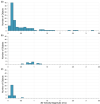Reconstruction of Bennu Particle Events From Sparse Data
- PMID: 32999897
- PMCID: PMC7507751
- DOI: 10.1029/2019EA000938
Reconstruction of Bennu Particle Events From Sparse Data
Abstract
OSIRIS-REx began observing particle ejection events shortly after entering orbit around near-Earth asteroid (101955) Bennu in January 2019. For some of these events, the only observations of the ejected particles come from the first two images taken immediately after the event by OSIRIS-REx's NavCam 1 imager. Without three or more observations of each particle, traditional orbit determination is not possible. However, by assuming that the particles all ejected at the same time and location for a given event, and approximating that their velocities remained constant after ejection (a reasonable approximation for fast-moving particles, i.e., with velocities on the order of 10 cm/s or greater, given Bennu's weak gravity), we show that it is possible to estimate the particles' states from only two observations each. We applied this newly developed technique to reconstruct the particle ejection events observed by the OSIRIS-REx spacecraft during orbit about Bennu. Particles were estimated to have ejected with inertial velocities ranging from 7 cm/s to 3.3 m/s, leading to a variety of trajectory types. Most (>80%) of the analyzed events were estimated to have originated from midlatitude regions and to have occurred after noon (local solar time), between 12:44 and 18:52. Comparison with higher-fidelity orbit determination solutions for the events with sufficient observations demonstrates the validity of our approach and also sheds light on its biases. Our technique offers the capacity to meaningfully constrain the properties of particle ejection events from limited data.
©2020. The Authors.
Figures







Similar articles
-
Initial Orbit Determination and Event Reconstruction From Estimation of Particle Trajectories About (101955) Bennu.Earth Space Sci. 2020 Sep;7(9):e2019EA000937. doi: 10.1029/2019EA000937. Epub 2020 Sep 19. Earth Space Sci. 2020. PMID: 33043099 Free PMC article.
-
Meteoroid Impacts as a Source of Bennu's Particle Ejection Events.J Geophys Res Planets. 2020 Aug;125(8):e2019JE006282. doi: 10.1029/2019JE006282. Epub 2020 Aug 16. J Geophys Res Planets. 2020. PMID: 32999798 Free PMC article.
-
Episodes of particle ejection from the surface of the active asteroid (101955) Bennu.Science. 2019 Dec 6;366(6470):eaay3544. doi: 10.1126/science.aay3544. Science. 2019. PMID: 31806784
-
Assessing the Sampleability of Bennu's Surface for the OSIRIS-REx Asteroid Sample Return Mission.Space Sci Rev. 2022;218(4):20. doi: 10.1007/s11214-022-00887-2. Epub 2022 Apr 19. Space Sci Rev. 2022. PMID: 35528719 Free PMC article. Review.
-
Ground and In-Flight Calibration of the OSIRIS-REx Camera Suite.Space Sci Rev. 2020;216(1):12. doi: 10.1007/s11214-019-0626-6. Epub 2020 Jan 23. Space Sci Rev. 2020. PMID: 32025061 Free PMC article. Review.
Cited by
-
Thermal Fatigue as a Driving Mechanism for Activity on Asteroid Bennu.J Geophys Res Planets. 2020 Aug;125(8):e2019JE006325. doi: 10.1029/2019JE006325. Epub 2020 Aug 20. J Geophys Res Planets. 2020. PMID: 32999800 Free PMC article.
-
Introduction to the Special Issue: Exploration of the Activity of Asteroid (101955) Bennu.J Geophys Res Planets. 2020 Sep;125(9):e2020JE006549. doi: 10.1029/2020JE006549. Epub 2020 Sep 9. J Geophys Res Planets. 2020. PMID: 33042723 Free PMC article.
-
Initial Orbit Determination and Event Reconstruction From Estimation of Particle Trajectories About (101955) Bennu.Earth Space Sci. 2020 Sep;7(9):e2019EA000937. doi: 10.1029/2019EA000937. Epub 2020 Sep 19. Earth Space Sci. 2020. PMID: 33043099 Free PMC article.
References
-
- Acton, C. H. (1996). Ancillary data services of NASA's Navigation and Ancillary Information Facility. Planetary and Space Science, 44(1), 65–70. 10.1016/0032-0633(95)00107-7 - DOI
-
- Acton, C. , Bachman, N. , Semenov, B. , & Wright, E. (2017). A look towards the future in the handling of space science mission geometry. Planetary and Space Science, 150, 9–12. 10.1016/j.pss.2017.02.013 - DOI
-
- Barnouin, O. S. , Daly, M. G. , Palmer, E. E. , Gaskell, R. W. , Weirich, J. R. , Johnson, C. L. , Al Asad, M. M. , Roberts, J. H. , Perry, M. E. , Susorney, H. C. M. , Daly, R. T. , Bierhaus, E. B. , Seabrook, J. A. , Espiritu, R. C. , Nair, A. H. , Nguyen, L. , Neumann, G. A. , Ernst, C. M. , Boynton, W. V. , Nolan, M. C. , Adam, C. D. , Moreau, M. C. , Rizk, B. , Drouet D'Aubigny, C. Y. , Jawin, E. R. , Walsh, K. J. , Michel, P. , Schwartz, S. R. , Ballouz, R.‐L. , Mazarico, E. M. , Scheeres, D. J. , McMahon, J. W. , Bottke, W. F. , Sugita, S. , Hirata, N. , Hirata, N. , Watanabe, S.‐I. , Burke, K. N. , Dellagiustina, D. N. , Bennett, C. A. , Lauretta, D. S. , & Osiris‐Rex Team (2019). Shape of (101955) Bennu indicative of a rubble pile with internal stiffness. Nature Geoscience, 12(4), 247–252. 10.1038/s41561-019-0330-x - DOI - PMC - PubMed
-
- Bos, B. , Jackman, C. , & Lauretta, D. S. (2019). Origins, Spectral Interpretation, Resource Identification, Security, Regolith Explorer (OSIRIS‐REx): Touch‐and‐Go Camera Suite (TAGCAMS) bundle. NASA Planetary Data System, urn:nasa:pds:orex.tagcams, https://sbn.psi.edu/pds/resource/orex/tagcams.html
-
- Bos, B. J. , Ravine, M. A. , Caplinger, M. , Schaffner, J. A. , Ladewig, J. V. , Olds, R. D. , Norman, C. D. , Huish, D. , Hughes, M. , Anderson, S. K. , Lorenz, D. A. , May, A. , Jackman, C. D. , Nelson, D. , Moreau, M. , Kubitschek, D. , Getzandanner, K. , Gordon, K. E. , Eberhardt, A. , & Lauretta, D. S. (2018). Touch and Go Camera System (TAGCAMS) for the OSIRIS‐REx Asteroid Sample Return Mission. Space Science Reviews, 214(37), 23 10.1007/s11214-017-0465-2 - DOI
LinkOut - more resources
Full Text Sources
